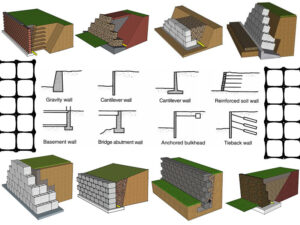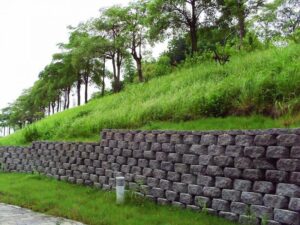Geomembrane, Geogrid, Geocell, Geotextile Used For Road Construction
Road construction must meet specific load-bearing and durability requirements, which are critical for the development of transportation infrastructure. The use of geomembranes, geogrids, geocells, and geotextiles has significantly enhanced the stability, drainage, and reinforcement of roadbeds in the construction of gravel, asphalt, muddy, or grassy driveways, revolutionizing road construction.
Geomembranes in road construction are primarily used to prevent water infiltration that could weaken the roadbed, especially in areas with high groundwater levels or sections that require additional moisture protection.
Geogrids increase the load-bearing capacity of driveways, reinforce the roadbed, and extend the lifespan of the pavement.
Geocells help contain soil, prevent erosion, and enhance the stability of embankments. They distribute traffic loads evenly, reduce settlement, and improve the road’s durability.
Geotextile fabric are commonly used to separate the subgrade soil from the pavers, preventing the mixing of different materials. They also facilitate drainage while preventing soil particles from entering the drainage system. This greatly enhances the lifespan of the pavement and reduces maintenance needs.
The use of these materials is essential for building resilient roads that can withstand traffic loads and environmental challenges.
Overview of Geomembranes, Geogrids, Geocells, and Geotextiles
Geomembranes, geogrids, geocells, and geotextile membrane primarily enhance the stability and reinforcement of roadbeds in road construction. You can click the button below to learn more about each geosynthetic material.
Geotextile
Geocell
Geogrid
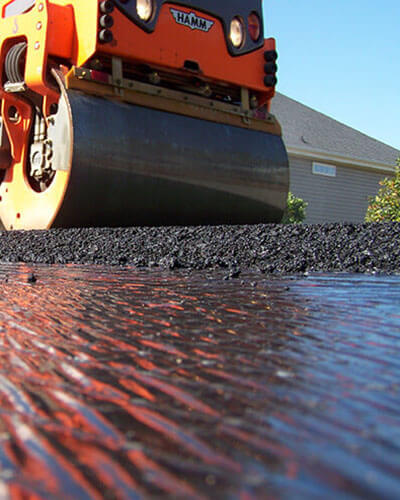
Geomembrane In Road Construction
Geomembranes, with their strong waterproofing capabilities, are commonly used in areas requiring effective water and seepage control, helping to protect road subgrades and foundations from water damage.
As an impermeable barrier, geomembranes prevent water from seeping into the road foundation, which is crucial in areas with high groundwater levels, heavy rainfall, or roads built on soft soil. By blocking water, geomembranes reduce soil saturation, preventing the road foundation from weakening or collapsing.
When placed beneath the pavement layer, geomembranes help stabilize the roadbed by preventing water infiltration. Water can soften and destabilize the road base, leading to deformation or settlement. Geomembranes act as a protective layer, preserving the integrity of the road foundation, especially in areas with poor soil conditions.
In cold regions, geomembranes limit water ingress into the soil, preventing frost heave, where water freezes and expands, causing cracks and bumps in the pavement. By controlling moisture beneath the surface, geomembranes help mitigate the effects of freeze-thaw cycles.
In environmentally sensitive areas such as wetlands, geomembranes provide a barrier that prevents road runoff from contaminating the surrounding ecosystem. This ensures that harmful substances like oil, fuel, and other pollutants do not seep into groundwater or soil.
Geomembranes can be combined with geotextiles to form a separation layer between different soil types, such as soft soil and pavers. This separation prevents material mixing, which could otherwise compromise the stability and drainage capacity of the road.
In road construction, geomembranes play a vital role in maintaining road stability and extending its lifespan by providing waterproofing, roadbed protection, and environmental safeguards. They are particularly beneficial in areas with challenging soil conditions, high groundwater levels, or extreme weather patterns.
For example, roads passing through bridges and tunnels, steep slopes and dams, and roads in wetlands or marshy areas become more resilient and require less long-term maintenance using geomembranes.
Geogrid For Road Construction
The use of geogrids in road construction is an important solution for improving road structural integrity, enhancing the stability and durability of the road foundation.
Geogrids are placed in the subbase or base layer of roads to reinforce the soil and improve its load distribution capacity. By interlocking with the soil or paving materials, they distribute traffic loads more evenly over a larger area, preventing lateral movement and improving the overall stability of the road structure. This reduces the pressure on soft soils beneath the pavement and prevents deformations such as rutting or settlement, which are common in unreinforced driveways.
By reinforcing the subgrade, geogrid fabric can reduce the thickness of aggregate layers while maintaining or even improving driveway performance. This can significantly cut down on material and transportation costs, especially for large projects where aggregate transport is expensive.
In areas with variable or soft soil conditions, geo grids help prevent differential settlement, thereby preventing pavement cracking or unevenness. They provide a strong, stable foundation for roads, reducing the risk of localized subsidence or failures.
Driveways reinforced with geogrids fabric tend to have longer lifespans as they can withstand traffic loads without premature wear. The use of geogrids minimizes maintenance costs and reduces the need for frequent repairs.
Examples:
On highways, industrial pathways, under concrete pavements, and sidewalks, geogrids are installed within the base layers to improve the structural integrity of the driveway, enhance the stability of the subgrade, and extend the road’s lifespan.
In flexible pavement systems, geogrids are placed beneath the asphalt layer to reduce cracking and deformation caused by repeated traffic loads. This improves the pavement’s fatigue resistance and extends its service life.
In private residences or remote rural areas, geogrids are used in gravel driveways, grass driveways, and similar applications. By reinforcing the soil and interlocking with paving materials like gravel, they enhance the structural stability, load-bearing capacity, and durability of the driveway, ensuring safety and long-term stability.
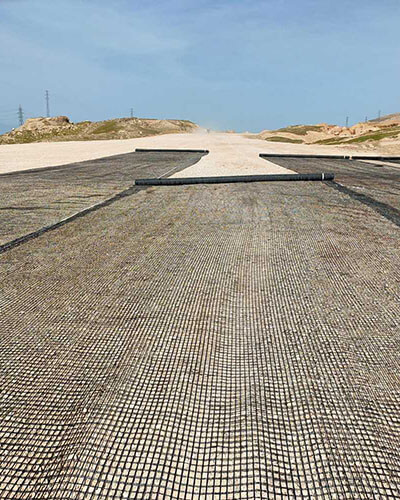
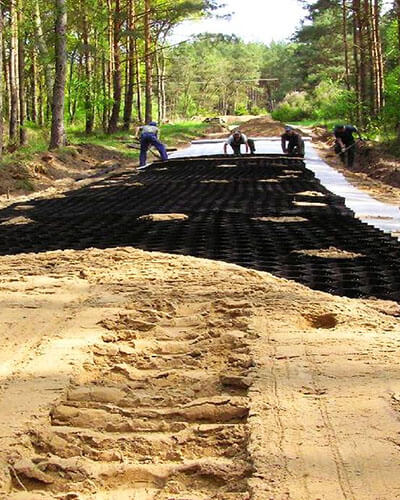
Geocells in Road Construction
The use of geocells in road construction is a highly effective technique for reinforcing soft soils, improving soil stability, load distribution, and erosion control. Geocells are especially beneficial for building driveway in soft soil, erosion-prone areas, or for temporary construction access routes.
Geocells are a three-dimensional honeycomb-like structure made from polymer materials such as HDPE. They have a strong capacity to confine and reinforce soil and fill materials, distributing loads more evenly.
As a result, geocells are ideal for projects where soil strength is a concern or where cost-effective solutions are needed to build durable road infrastructure.
Geocells work by distributing traffic loads over a larger area, reducing pressure on the underlying roadbed. This helps prevent issues like rutting and settlement, especially on driveway built over soft or compressible soils. The confinement provided by geocells significantly improves the load-bearing capacity of the road foundation.
By confining fill material or soil within the cells, geocells prevent lateral movement, providing stability to the base and subbase layers. This creates a strong reinforcement layer capable of supporting heavy traffic loads and minimizing pavement deformation over time.
In steep slopes or embankment areas, geocells are highly effective for erosion control. The 3D structure holds soil in place, preventing it from being washed away by rain or runoff. This makes geocells an ideal solution for protecting driveways in hilly or flood-prone areas.
By reinforcing the soil and fill layers, geocells can reduce the thickness of the subbase without compromising road performance. This results in cost savings for materials and transportation, while still delivering a stable, durable road structure.
Geocells can be used to reinforce both flexible and rigid pavements, ensuring the longevity of roads by reducing deformation and cracking. They help maintain the road structure under heavy loads from trucks and construction vehicles, preventing roadbed shifting and ensuring long-term durability.
Example:
For constructing temporary driveways and access routes, geocells reinforce the roadbed by confining the soil within the cells, improving road performance.
For highways or industrial roads, where lanes must maintain high performance over time, geocells can be filled with materials such as sand or gravel to reinforce the subbase, increasing the road’s ability to support heavy loads and extending its lifespan.
For low-traffic roads in rural areas and homes, geocells can easily improve road structure without the need for expensive pavement. By reinforcing the base and reducing the amount of fill material needed, geocells make it easier to build economical and durable unpaved roads.
Geotextile fabric in Road Construction
The use of geotextiles fabric in road construction is crucial for improving soil stability, separation, filtration, drainage, and reinforcement.
Geofabric are particularly valuable in projects where soil conditions are poor or where traffic loads are heavy and require additional support. For example, geotextiles membrane are used in muddy roads, placed beneath asphalt or gravel layers.
By enhancing the stability and longevity of the driveway structure, geotextiles help reduce maintenance costs and extend the lifespan of the driveway.
Made from permeable synthetic materials such as polypropylene or polyester, the two main types of geotextiles used in road construction are woven geotextiles fabric and non-woven geotextiles fabric.
One of the primary uses of geo fabrics in road construction is to provide separation between different material layers, such as the subgrade and the base course. This prevents fine subgrade soils from mixing with the base layer materials, which could otherwise reduce the strength and stability of the driveway. By maintaining the distinction between layers, geotextiles help preserve the structural integrity of the road.
Geotextile fabric can also be used to reinforce soft soils by enhancing the stability of the subgrade. When placed between the subgrade and base layers, geotextiles evenly distribute traffic loads, reducing pressure on the underlying soil. This helps prevent rutting, settlement, and deformation, improving the driveway’s stability, especially in areas with soft or unstable soils.
Geotextile membranes allow water to pass through while preventing soil particles from moving between layers, especially for permeable base materials. This filtration function is critical for maintaining proper drainage in road engineering. It ensures that water can be drained from the road structure while preventing soil from clogging drainage systems or entering the base layer.
Geotech fabrics also play a vital role in drainage, as they can be combined with drainage systems to facilitate water flow out of the driveway. By allowing water to pass through the fabric while retaining soil particles, geotextiles prevent water accumulation within the road structure, which could lead to erosion, pavement damage, or frost heave in colder climates.
In road construction, especially in embankments, slopes, and roadside ditches, geotextiles help control erosion by keeping soil in place while allowing water to flow freely. This feature is particularly important in areas with heavy rainfall or where runoff might erode the roadbed or surrounding soil.
Example:
In areas with weak or compressible soils, such as muddy regions, geofabrics enhance the stability of the road foundation by preventing the mixing of subgrade and pavers. This improves the durability of the road by reinforcing the foundation.
When geotextile fabric is placed under asphalt, it acts as a separation layer between the base and subgrade, reinforcing the road structure. This helps reduce cracking and rutting over time, extending the lifespan of the driveway, especially in areas with heavy traffic or large loads.
Geo fabrics are also laid under gravel roads. Gravel, being a permeable, loose material, requires proper drainage and filtration to remain functional over time. By placing geotextiles under the gravel, water flow is promoted while keeping soil out of the drainage system. This ensures that the road’s drainage system continues to work properly, protecting the road from water damage and weakening of the roadbed.
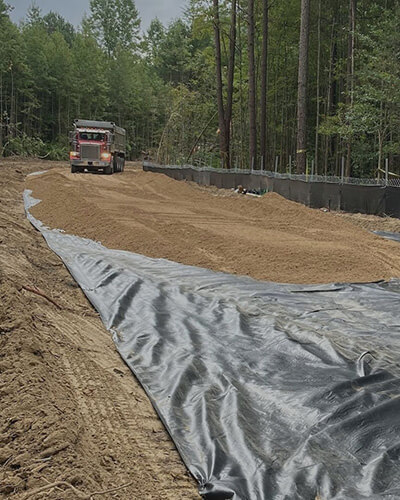
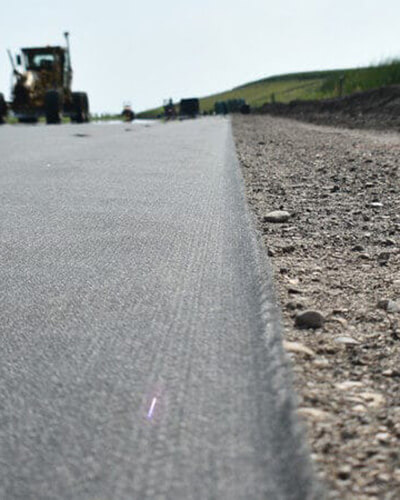
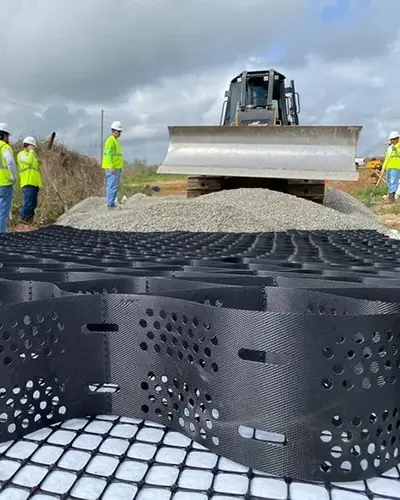

How to Choose Geomembranes, Geogrids, Geocells, and Geotextiles for Road Construction
The selection of geomembranes, geogrids, geocells, or geotextiles in road construction depends on the specific project requirements.
Soil conditions, load-bearing needs, drainage requirements, and environmental factors must be considered.
Each of these geosynthetic materials plays a unique role in road construction, and the choice should be based on the type of problem to be addressed.
In many cases, multiple geosynthetic materials can be used together for optimal results.
1. Understand Project Requirements
The first step is to assess the specific challenges of the road construction project. Factors such as soil conditions, load requirements, drainage, environmental considerations, and expected traffic loads are crucial in determining which geosynthetic material will be most effective.
Key considerations include:
Soil Strength: Is the subgrade weak or compressible?
Load Requirements: Will the driveway support heavy traffic loads, such as trucks or industrial equipment?
Water Management: Is the area prone to waterlogging, flooding, or high groundwater levels?
Erosion Risk: Will the road pass through steep slopes or embankments with soil erosion issues?
2. Evaluate the Functions of Each Material
Each geosynthetic material offers specific advantages tailored to different project needs:
Geomembranes: An impermeable liner used to prevent liquid migration. Ideal for roads near water bodies, wetlands, or where subgrade waterproofing is required.
Geogrids: Used to reinforce soil stability by increasing load-bearing capacity. Suitable for roads with heavy traffic or areas where soil strength needs to be enhanced, such as highways.
Geocells: A three-dimensional honeycomb structure that confines soil and improves load distribution. Best for projects requiring slope stabilization, erosion-prone roads, or where deep excavation is not feasible.
Geotextiles: A permeable fabric used for separation, filtration, drainage, and reinforcement. It promotes water flow while keeping fine soil particles in place, making it ideal for road construction in areas with poor drainage or heavy rainfall. Choose woven geotextiles for strength and non-woven geotextiles for filtration and drainage.
3. Consider Environmental and Economic Factors
Geomembranes: Require proper installation to ensure impermeability. If water pollution or leakage is a significant concern, they are worth the investment.
Geogrids and Geocells: These materials are cost-effective for enhancing road stability, reducing the need for deeper excavations and expensive fill materials.
Geotextiles: Relatively inexpensive and versatile, they are often used in combination with other geosynthetics to improve overall performance.
Conclusion
In road construction, geomembranes, geogrids, geocells, or geotextiles are typically used in combination based on soil conditions, load capacity, water management, and environmental factors.
For example,
Asphalt roads use geotextiles fabric to separate the base layer from the subgrade, and geogrids to enhance road stability.
Gravel driveways use geofabrics to separate the soil from the permeable block paving of gravel, while geocells are used to contain the gravel and provide reinforcement to distribute loads.
Moisture barriers are used to control the expansion of clay subgrades by shielding the clay; geomembranes can minimize the chances of significant moisture variation within the pavement subgrade. This prevents uneven expansion and contraction that can damage the pavement as the moisture content of the clay increases. To maximize moisture control, geomembranes are installed on a lime-stabilized subgrade and covered with a layer of gravel. A continuous reinforced concrete pavement with a drainage base is laid over the gravel.
Recent Projects
Discover our recent client projects and explore the range of tailored, personalized support we provide. Share your requirements and receive the ideal solution.
Recent Company News
Explore our newest releases, stay informed with industry updates on geosynthetics & geocomposite, and delve into technical insights about geotechnical products. For any queries, reach out to us for customized assistance.
Frequently Asked Questions
You can refer to the following pages to learn about the installation requirements and challenges for each type of geosynthetic material:
Different road construction projects face varying challenges, leading to significant differences in the selection of material specifications. For instance, the tensile strength, permeability, and durability of materials can differ.
Here, QIVOC recommends that you contact us and provide the relevant project data to receive personalized technical support.
Different geosynthetic materials are needed for various soil conditions.
For example:
Clay soils benefit from the reinforcement provided by geogrids and geocells, while geomembranes offer water control, and geotextiles provide separation and filtration.
Sandy soils require stabilization, which can be provided by geogrids and geocells, while geotextiles manage drainage and prevent soil erosion.
Rocky soils need protection for geosynthetic materials against sharp edges. Geogrids and geocells provide load distribution, and geotextiles act as separators to prevent contamination of road materials.
Each material plays a crucial role in enhancing road performance based on soil type, ensuring long-term stability and functionality.
In road construction, the lifespan of geomembranes is 20-30 years, geogrids over 50 years, geocells 20-30 years, and geotextiles 10-50 years.
These materials require minimal maintenance, only needing regular inspections of the pavement condition. If there are signs of settlement or collapse in the pavement, it is necessary to excavate the surface and reinstall the corresponding geosynthetic materials.
In all cases, proper installation and regular inspections are key to maximizing the lifespan and improving the performance of the roadway.
The cost differences among materials mainly focus on purchase prices and subsequent installation and maintenance expenses.
The costs of geogrids for driveways and geotextiles for roads are relatively low. In contrast, geomembranes and geocells are relatively higher in price. QIVOC is currently selling these road materials; you can contact us for timely pricing information.
Subsequent installation and maintenance costs are reflected in the materials’ lifespan and installation complexity.
For example, while the initial costs of geogrids may be higher, they can save money in the long run by extending the lifespan of the pavement and reducing maintenance costs.
Installing geomembranes requires specialized geomembrane welding machines and skilled personnel for welding, as well as air pressure testing equipment to ensure proper weld quality. This results in higher equipment and labor costs.



